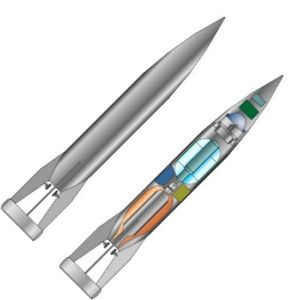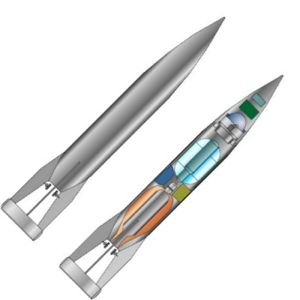
Home - Search - Browse - Alphabetic Index: 0- 1- 2- 3- 4- 5- 6- 7- 8- 9
A- B- C- D- E- F- G- H- I- J- K- L- M- N- O- P- Q- R- S- T- U- V- W- X- Y- Z
A3
 A3 Credit: © Mark Wade |
Status: Retired 1937. First Launch: 1937-12-04. Last Launch: 1937-12-11. Number: 4 . Thrust: 14.70 kN (3,305 lbf). Gross mass: 740 kg (1,630 lb). Height: 6.74 m (22.12 ft). Diameter: 0.67 m (2.21 ft). Span: 0.93 m (3.05 ft).
The rocket's expected longer range required moving the launch site from Kummersdorf to the island of Greifwalder Oie (offshore of the permanent new rocket test facilities being built at Peenemuende). All of the test launches were failures. A total redesign, the A5, was used for subscale development of A4 technology. Propellants were Lox and 75% alcohol, and burn time was 45 seconds. A notable A3 innovation was a liquid nitrogen tank (inside the liquid oxygen tanks) which was heated by small electrical elements to provide gaseous nitrogen to pressure-feed the propellants. A small film camera recorded instrument readings in the nose.
Family: test vehicle. People: von Braun. Country: Germany. Launch Sites: Kummersdorf, Peenemuende, Peenemuende GWO. Bibliography: 17, 394, 693, 86.
 | A3 Credit: © Mark Wade |
February 1936 - . LV Family: V-2. Launch Vehicle: A3.
- A3 rocket tested. - . Nation: Germany. Related Persons: von Braun. Germans tested A-3 rocket with 1,500 kgf thrust which served as basis for military weapon specifications..
July 1936 - . Launch Site: Peenemuende. Launch Complex: Peenemuende. LV Family: V-2. Launch Vehicle: A3.
- A4 wind tunnel tests - .
Nation: Germany.
The tests showed that the A3 configuration was unstable in flight and that it was going to take a lot of trial and error to identify the correct aerodynamic shape for the supersonic missile. Therefore the decision was taken to go slow on development of the A4 until tests with the A3 were complete. The 25 tonne thrust engine would also have to be built and proven in ground tests to determine its actual characteristics before a lot of effort was put into final design and construction of the rest of the rocket. So a series of test launches of the A3 to test the A4 control and guidance systems were undertaken, while Test Stand I at Peenemuende was prepared for tests of the 25 tonne engine.
1937 December 4 - . Launch Site: Peenemuende. Launch Complex: Peenemuende GWO. LV Family: V-2. Launch Vehicle: A3. FAILURE: Engine cutoff at 6.5 seconds.. Failed Stage: 1.
- First A3 launch - .
Nation: Germany.
Related Persons: von Braun.
Apogee: 0.10 km (0.06 mi). Range: 0.30 km (0.19 mi).
First launch of an A3 rocket. New facilites being built at Peenemuende were not ready, so the A3 launches were made from the offshore island of Greifswalder Oie. The A3 launched on this day was 6.5 m long and 70 cm in diameter. The engine occupied the first 2 m of the fuselage. The missile had a 750 kg lift-off mass, including 450 kg of propellant, which was pressurised to 20 atmospheres. The 1.5 tonne thrust engine had a 1900 m/s exhaust velocity and a 45 second burn time. The parachute deployed 3 seconds after launch, and the engine cutoff at 6.5 seconds. The rocket impacted and exploded 300 m from the launch point.
1937 December 6 - . Launch Site: Peenemuende. Launch Complex: Peenemuende GWO. LV Family: V-2. Launch Vehicle: A3. FAILURE: Engine cutoff early.. Failed Stage: 1.
- A3 launch - . Nation: Germany. Related Persons: von Braun. Apogee: 0.10 km (0.06 mi). Range: 0.30 km (0.19 mi). Second launch of an A3. Same result as the first - the rocket made a quarter turn after launch, then reached only 100 m before the parachute jettisoned and the missile crashed into the sea a short distance from the launch stand..
1937 December 8 - . Launch Site: Peenemuende. Launch Complex: Peenemuende GWO. LV Family: V-2. Launch Vehicle: A3. FAILURE: Engine cutoff early.. Failed Stage: 1.
- A3 launch - . Nation: Germany. Related Persons: von Braun. Apogee: 0.10 km (0.06 mi). Range: 0.30 km (0.19 mi). Third launch of an A3. No parachute deployment and the engine cut-off early. The rocket impacted into the Baltic Sea and sank..
1937 December 11 - . Launch Site: Peenemuende. Launch Complex: Peenemuende GWO. LV Family: V-2. Launch Vehicle: A3. FAILURE: Engine cutoff early.. Failed Stage: 1.
- A3 launch - .
Nation: Germany.
Related Persons: von Braun.
Apogee: 1.00 km (0.60 mi).
Final launch of the A3. The rocket is fired without the parachute that ruined the first two attempts, but in heavy fog. It is more successful than earlier shots, but at 800 to 1000 m altitude it also veers over and thrusts its way downward into the ocean. Analysis showed that the fins steering the rocket could not overcome the 8 m/s wind blowing at the time of the launch. Further study shows that at the low speed of initial rocket acceleration, a wind as little as 4 m/s would be enough to topple the rocket. A rudder area ten times greater than is needed to control the rocket at low speeds. This result leads to the decision to abandon the A3 configuration and build the A5 to support development of the A4 missile.
Spring 1938 - . Launch Site: Peenemuende. Launch Complex: Peenemuende. LV Family: V-2. Launch Vehicle: A3, A5.
- A5 delivered to Peenemuende. - .
Nation: Germany.
The first A5 drop test model is delivered to Peenemuende just weeks after the third A3 test. Production is planned at a rate of 10 per month to define the A4 aerodynamic configuration. Objective of the first tests is to break the sound barrier - in the wind tunnel no configuration of fins had managed to go through the barrier without disintegrating. The only test possibility was to drop the model from a great height, and let gravity accelerate it to supersonic speeds. The model weighs 250 kg and is 1.6 m long and 20 cm in diameter.
1939 March 23 - . Launch Site: Kummersdorf. Launch Complex: Kummersdorf. LV Family: V-2. Launch Vehicle: A3.
- Hitler visits Kummersdorf-West - .
Nation: Germany.
Related Persons: Dornberger,
Hitler,
Valier.
This was the first time he became acquainted with liquid rocket engine technology. 300 kgf and 1000 kgf engines were fired in his presence. A colour-coded cutaway model of the A3 rocket was presented and its systems explained. Hitler was quiet throughout the exhibits and asked no questions. Afterwards, while taking lunch at the mess hall, he asked only about the development schedule (clucking when told), the range of the missile, and the impact on the schedule if synthetic 'Eisenbled' was substituted for light metal alloys in the rocket frame. Hitler spoke of deceased rocket pioneer Max Valier - he had known him in Munich, but dismissed him as a dreamer. Dornberger countered by comparing the state of rocket development to the early days of the zeppelin, when Lillienthal made the first primitive experiments. Hitler in turn dismissed airships as dangerous, filled with explosive gas . The Fuehrer finally departed with handshakes and few words. His summary of the day: 'Es war doch gewaltig' (it was impressive, nevertheless). The rocket team was dismayed - it was the first time a visitor had exhibited no reaction to the power the rocket engines when fired for their benefit. But on the plus side, Von Brauchtisch said he was astounded at the progress made by the team in only a few years. Dornberger believed Hitler was enthralled with artillery and tanks, and was unimpressed with rocket technology. He thought Hitler didn't understand the possibilities and didn't believe the time had come yet for development of the rocket as a weapon.
Back to top of page
Home - Search - Browse - Alphabetic Index: 0- 1- 2- 3- 4- 5- 6- 7- 8- 9
A- B- C- D- E- F- G- H- I- J- K- L- M- N- O- P- Q- R- S- T- U- V- W- X- Y- Z
© 1997-2019 Mark Wade - Contact
© / Conditions for Use